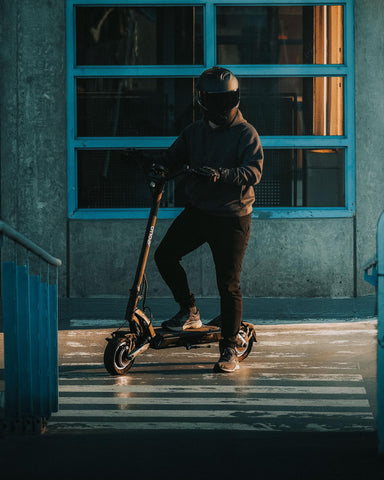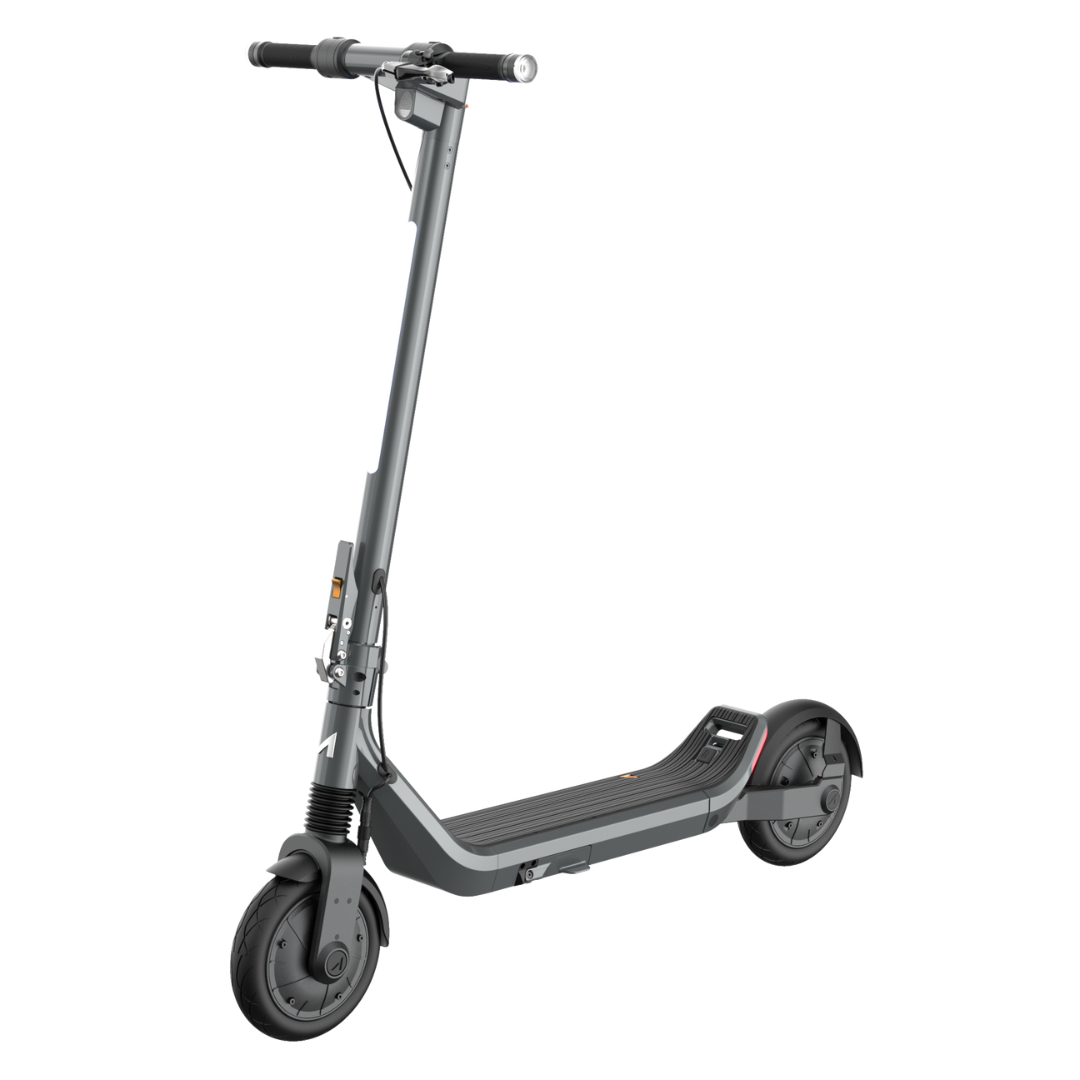The legal landscape in the United States is a colorful mosaic of different regulations for each state. Trying to stay up to date may seem overwhelming, but worry not, and read on for the lowdown on what you can and cannot do on your e-scooter in 2024.
This blog post is a continuation of our article from last year: Electric Scooter Laws in the United States 2023.
Key Takeaways
- Electric scooter regulations in 2024 are primarily location-specific, with state and city ordinances dictating the varied rules, including speed limits, licensing, and safety equipment requirements that e-scooter riders must follow.
- Major warm cities like Los Angeles, Miami, and Austin each have unique electric scooter laws, often including specific conditions for riding, parking, and safety protocols to accommodate year-round scooter use.
- Rider safety is a core focus of e-scooter regulations, emphasizing the need for proper safety gear such as helmets, appropriate lighting for visibility, and adherence to age restrictions to ensure the well-being of riders and the public.
Electric Scooter Laws in 2024: What's New?
The landscape of electric scooter laws in 2024 has been molded by a series of local regulations rather than sweeping legislative overhauls. Despite the absence of significant legal changes at the national level, there’s been an explosion of specific local laws that electric scooter riders have to abide by. Given the swift pace of legal changes, it’s paramount for e-scooter enthusiasts to stay up to date.
Many states consider electric scooters to be low speed electric vehicles, but specifics differ from state to state. Electric scooters are categorized in the same way as electric bicycles, so the laws for riding electric scooters are similar. However, do not be lulled into a false sense of security - the details can often be the trickiest part, and these local nuances may catch riders off guard.
Federal regulations on electric scooters
At the federal level, electric scooters fall under specific legislation restricting their power and speed. According to the regulations, electric scooters shouldn't exceed a maximum speed of 20 mph and are allowed on roads if they have an electric motor of 750 Watts or lower. This is in line with the classification of low-speed electric vehicles, which also includes e-bikes.
State-level regulations bring a whole new level of complexity to the legal landscape of electric scooters. From varying speed limits to licensing and helmet requirements, the laws seem like a maze for riders.
Laws and regulations on e-scooters by state
 Photo by JOSHUA COLEMAN on Unsplash
Photo by JOSHUA COLEMAN on Unsplash
California
In California, electric scooters are a popular mode of transportation, especially in urban areas. Riders must have a valid driver's license or learner's permit and are required to wear a helmet if under 18. Scooters can't be ridden on sidewalks and must stick to bike lanes or roads with a speed limit of 35 mph or less. The maximum speed for an electric scooter is 15 mph.
New York
New York has recently embraced electric scooters, legalizing their use with specific regulations. Riders must be 16 or older, and those under 18 are required to wear helmets. Riding e-scooters on sidewalks or streets with a speed limit of more than 30 mph is illegal. The maximum speed limit for scooters is 20 mph.
Florida
Florida allows electric scooters to be used on streets and bike paths but prohibits them from sidewalks. Riders must follow the same rules as bicyclists, including adhering to traffic signals and signs. There is no statewide helmet law for electric scooter riders, but local ordinances may require them.
Texas
Texas classifies electric scooters similarly to bicycles, allowing them on roads, bike lanes, and sidewalks unless prohibited by local ordinance. There is no state-wide helmet requirement, but cities like Austin have their own rules, including age restrictions and areas where scooters can be used.
Virginia
Virginia law permits electric scooters on sidewalks, shared-use paths, and roads with a speed limit of 25 mph or less. Riders must be at least 14 years old, and those under 14 must be accompanied by an adult. Local jurisdictions may impose additional regulations, including helmet requirements.
Washington
In Washington, electric scooters can be ridden on roads, bike lanes, and sidewalks, though riding on sidewalks may be restricted in crowded areas. Helmets are required for all riders, and the maximum speed limit for electric scooters is 15 mph.
Illinois
Illinois allows electric scooters on bicycle paths and roads with a speed limit of 30 mph or less. Riders must yield the right of way to pedestrians and give an audible signal when overtaking and passing a pedestrian. Local municipalities may have additional regulations, including helmet requirements.
Georgia
Georgia treats electric scooters similarly to bicycles, allowing them on roads and in bike lanes but not on sidewalks. Riders are encouraged to wear helmets, though it's not a state requirement. Local laws, such as in Atlanta, may have specific regulations, including designated parking areas for scooters.
North Carolina
North Carolina's electric scooter regulations vary by city. Generally, scooters are allowed on roads, bike lanes, and sidewalks, with speed limits mirroring those of bicycles. Helmet use is strongly recommended, and some cities require them for riders under 16.
Ohio
Ohio's law allows electric scooters on roads and bike paths but prohibits them from sidewalks. Riders must adhere to the same rules as bicyclists, including traffic laws and signaling. Helmets are recommended but not required by state law.
Pennsylvania
In Pennsylvania, electric scooters are classified as "pedal cycles with electric assist," allowing them on roads, bike lanes, and sidewalks where bicycles are permitted. Riders must follow traffic laws, and helmets are recommended for all riders and required for those under 12.
Michigan
Michigan allows electric scooters on sidewalks, bike lanes, and roads with a speed limit of 25 mph or less. Riders are encouraged to follow bicycle laws, including signaling and adhering to traffic signs. Helmet use is recommended, especially for minors.
Massachusetts
Massachusetts requires electric scooter riders to have a valid driver's license or learner's permit. Scooters can be used on bike paths, roads, and sidewalks, with a speed limit of 20 mph. Helmets are required for riders under 18.
Oregon
In Oregon, electric scooters are allowed on roads with a speed limit of 25 mph or less, bike lanes, and sidewalks, though riding on sidewalks is discouraged in crowded areas. Riders must be 16 or older, and helmets are required for those under 16.
Indiana
Indiana permits electric scooters on public roads and bike lanes but not on sidewalks. The state recommends helmet use for all riders and requires them for those under 18. Local ordinances may have additional restrictions, including speed limits and designated parking zones.
Colorado
Colorado's electric scooter laws allow them on bike lanes and roads with a speed limit of 30 mph or less. Helmets are recommended for all riders and required for those under 18. Local jurisdictions may impose further regulations, including no-ride zones and speed limits.
New Jersey
New Jersey requires electric scooter riders to be at least 15 years old and recommends helmet use for all riders, mandating it for those under 17. Scooters can be used on roads, bike lanes, and sidewalks, with a maximum speed limit of 19 mph.
Arizona
Arizona treats electric scooters similarly to bicycles, allowing them on bike lanes, roads, and sidewalks. There are no state-wide helmet laws, but local municipalities may require them. Riders are encouraged to follow traffic laws and use lights at night.
Nevada
Nevada allows electric scooters on sidewalks, bike paths, and roads where the speed limit is 35 mph or less. Riders are encouraged to wear helmets, and those under 18 are required to do so. Local laws, such as in Las Vegas, may have additional regulations.
Tennessee
Tennessee has embraced electric scooters, allowing them on roads, bike lanes, and sidewalks in some areas. Riders must be 16 or older and are encouraged to wear helmets. Local ordinances, such as in Nashville, may specify additional rules, including no-ride zones.
Maryland
Maryland permits electric scooters on roads, bike lanes, and sidewalks, with a maximum speed limit of 20 mph. Helmet use is recommended for all riders and required for those under 16. Local jurisdictions may have additional regulations.
South Carolina
South Carolina's laws on electric scooters are evolving, with regulations varying by city. Generally, scooters are allowed on streets and bike paths, with helmet use recommended for safety. Local ordinances may specify age requirements and helmet mandates.
Minnesota
Minnesota allows electric scooters on roads, bike lanes, and sidewalks, with a maximum speed limit of 15 mph. Riders are encouraged to wear helmets, and those under 18 may be required to do so by local law. Scooters must have front and rear lights for night riding.
Kentucky
Kentucky permits electric scooters on roads, bike lanes, and sidewalks, treating them similarly to bicycles. Riders are encouraged to follow traffic laws and wear helmets for safety. Local ordinances may have specific rules, including speed limits and parking regulations.
Missouri
Missouri allows electric scooters on sidewalks, bike lanes, and roads with a speed limit of less than 30 mph. Helmet use is recommended for all riders and required for those under 17. Local laws may have additional requirements, including age restrictions.
Iowa
In Iowa, electric scooters are allowed on bike lanes and roads but not on sidewalks. Riders are encouraged to wear helmets and must adhere to traffic laws. Local ordinances can impose additional restrictions, including specific areas where scooters are prohibited.
Wisconsin
Wisconsin treats electric scooters similarly to bicycles, allowing them on roads, bike lanes, and sidewalks, with local ordinances dictating specific regulations. Helmet use is recommended, and some areas may require them for younger riders.
Utah
Utah permits electric scooters on roads, bike lanes, and sidewalks, with a maximum speed limit of 15 mph. Riders are encouraged to wear helmets, and those under 18 are required to do so. Local laws may specify additional regulations, including designated parking areas.
Idaho
Idaho allows electric scooters on sidewalks, bike paths, and roads with a speed limit of 35 mph or less. While helmet use is not mandated by state law, it is strongly recommended for safety. Local ordinances may have further restrictions.
Connecticut
Connecticut allows electric scooters on roads and bike lanes but restricts them from sidewalks in some areas. Riders are encouraged to wear helmets, and those under 15 are required to do so. Local ordinances may specify additional rules, including speed limits and parking regulations.
Disclaimer
We strive to provide the most accurate information possible, but such regulations are prone to change. It’s best to double-check before you hit the road.
Riding Electric Scooters in Major US Cities: Warm Climate Focus
 Photo by Jake Blucker on Unsplash
Photo by Jake Blucker on Unsplash
In the sprawling metropolises of Los Angeles, Miami, and Austin, the e-scooter wave has hit with full force. The year-round warm climate in these cities makes them ideal for using e-scooters as a fun, efficient, and eco-friendly mode of transportation. However, just as with the state and federal laws, the local regulations in these cities have their own unique characteristics that riders need to be aware of.
Now, let’s delve into the e-scooter laws of these warm-climate cities. Keep in mind, being well-informed is empowering, and when it comes to riding e-scooters, it could mean the difference between receiving a fine and enjoying a fantastic ride!
Los Angeles, California
In the city of Angels, e-scooter riders have a few specific rules to follow on streets with speed limits. For starters, riders must use bike lanes, otherwise known as Class II Bicycle Lanes, when available and adhere to the maximum speed limit of 15 mph. This keeps the speed of e-scooters in line with bicycles, enhancing safety for all road users.
However, not all pathways are open for e-scooters in LA. Here are some important rules to follow:
- Riding on sidewalks is strictly forbidden
- Riders are required to have a valid driver’s license or learner’s permit
- Making left-hand turns while on an e-scooter requires the rider to dismount and cross on foot to avoid accidents
- E-scooters should be parked in designated areas, ensuring they do not block pedestrian pathways and are parked upright.
Here you can find more about e-scooter regulations in California, as well as some neat spots worth visiting: Routes and Laws: Exploring Places for Electric Scooter Rides in California.
Miami, Florida
In Miami, e-scooters are governed by Chapter 8 of the city’s code of ordinances, which also encompasses bicycles and similar devices. Riders must operate their e-scooters in a safe and prudent manner, with a maximum speed of 15 mph in bike lanes or streets, and no more than 7 mph on sidewalks or in parks.
Parking, too, comes with its set of regulations. E-scooters must be parked on a sidewalk or hard surface, beside a bicycle rack, or at a designated city location without obstructing pedestrian or motor vehicles traffic.
So, if you plan to glide down Miami’s vibrant streets on an e-scooter, bear these guidelines in mind! You can also visit our comprehensive guide to Miami for e-scooter enthusiasts: Exploring Miami on Electric Scooters: Trails, Laws, and Everything In Between.
Austin, Texas
Austin, Texas, has its own unique set of e-scooter regulations. Unlike many other cities, e-scooters are permitted on sidewalks in Austin, provided they are operated in a manner that is safe and considerate of others. However, riders are expected to yield to pedestrians, bicyclists, and individuals with disabilities, ensuring a harmonious share of public pathways.
When it comes to parking, e-scooters should be parked in a way that leaves at least 3 feet of clear space on sidewalks and avoids obstructing bridges, creeks, rivers, and private properties. Designated parking spaces such as parking boxes and micromobility corrals are available for e-scooters and bicycles. So, if you’re in Austin, enjoy the liberty of sidewalk riding, but remember to do so responsibly!
E-Scooter Laws in Other Prominent US Cities
 Photo by Michael Discenza on Unsplash
Photo by Michael Discenza on Unsplash
While warm-climate cities provide a fantastic setting for e-scooter rides, let’s not forget the other prominent cities in the US where e-scooters have made their mark. Yes, we’re talking about the bustling metropolises of New York City, Chicago, and Seattle. These cities, despite their varying climates, have embraced the e-scooter wave and have their own unique set of regulations governing their use.
Now, let’s delve into these cities’ e-scooter laws. Regardless of whether you’re a local or just visiting, familiarizing yourself with these regulations will allow you to focus on enjoying your ride.
New York City, New York
Known for its bustling traffic and fast-paced life, New York City has quite a straightforward set of rules for e-scooter riders. As of November 23, 2020, all classes of e-bikes are allowed in New York City. E-scooter riders must not exceed a maximum speed of 15 MPH and are permitted in bike lanes and on streets where the speed limit does not exceed 30 MPH.
However, not all roads are open for e-scooters. Riding on sidewalks is strictly prohibited in New York City. Additionally, the operation of e-bikes and e-scooters within areas under the jurisdiction of NYC Parks must adhere to NYC Parks rules and regulations.
Chicago, Illinois
Chicago has specific e-scooter regulations that riders need to follow. These rules are designed to ensure the safety of riders and pedestrians alike. The city has implemented a pilot program to assess the feasibility and impact of e-scooters on the city’s transportation network.
The program involves several safety measures, including designated parking zones and speed limits. Violation of these rules can result in fines and penalties. So, if you are planning to whiz around the streets of Chicago on an e-scooter, make sure you are aware of the rules and regulations.
Seattle, Washington
Seattle has strict guidelines for e-scooter operation. Riders under 16 are not permitted to operate e-scooters, all riders must wear helmets, and e-scooters cannot carry more than one person. Like bicyclists and motorists, e-scooter riders must obey traffic laws, yield to pedestrians, and adhere to specific speed limits set by the Seattle Department of Transportation, especially in areas with heavy pedestrian traffic or designated speed-limited zones, ensuring they do not exceed these limits by more than 5 mph.
These regulations aim to integrate e-scooters into Seattle's transport ecosystem safely, promoting them as a sustainable and efficient travel option while prioritizing public safety.
Safety Requirements for Electric Scooter Riders

Now that we’ve covered the laws, let’s shift gears and focus on safety. After all, laws are implemented with safety in mind, right? So, what are the safety requirements for e-scooter riders? And how can you ensure a safe ride? Let’s dive in and find out.
The three key safety requirements for e-scooter riders are:
- Helmets: Most states require electric scooter riders to use helmets as part of their safety gear.
- Lighting: Proper lighting is essential for e-scooters to ensure rider visibility and safety during low-light conditions or at night.
- Age restrictions: Some states impose age restrictions on electric scooter riders, typically requiring a minimum age of 12 to 16 years old to operate e-scooters.
These safety requirements help ensure that you can enjoy your e-scooter rides without compromising your own safety or the safety of others on the road.
Helmets
Helmets are the primary safety gear for e-scooter riders. They are the most effective measure to prevent accidents and serious injury, particularly protecting against head injuries. Helmets are legally required by 10 states in the U.S., mostly for riders under the age of 18.
However, the requirements vary by state. For instance, Ohio, New Jersey, South Dakota, and Minnesota require helmet use for electric scooter riders, with specific age restrictions varying by state. States like Florida, Georgia, Alabama, and Arizona classify e-scooters as motorized vehicles and have helmet requirements, mostly for riders under the age of 18.
Therefore, always ensure to wear a helmet - whether it’s mandated by law or not! Better safe than sorry.
Lighting and visibility
Proper lighting is essential for electric scooters to ensure rider visibility and safety during low-light conditions or at night. E-scooters should be equipped with a white front light visible from a distance of at least 500 feet and a rear red light or reflector.
Various states have specific lighting requirements for e-scooters. For instance, Maine electric scooters require specific lighting at night, including a white front light and rear red or amber light accompanied by reflectors. Let there be light!
Age restrictions
Age restrictions for e-scooter riders vary by state, with a common minimum age of 16. Some states, like Nebraska and Tennessee, set the minimum age for e-scooter riders at 17 and 18 years old, respectively. Meanwhile, Delaware requires riders to be at least 12 if supervised, or 16 if unsupervised.
However, some states like Texas and Wyoming have not specified any minimum age limit for operating electric scooters. These age restrictions are put in place to ensure that riders have the maturity and skill to operate an e-scooter safely. So, make sure you’re of the right age before you hop on an e-scooter!
Tips for Complying with Electric Scooter Laws
By now, you’re probably well-versed in the latest e-scooter laws. But, knowing the laws is just the first step. Compliance is the key. So, how can you ensure that you’re following all the e-scooter laws? Here are some tips to help you out.
- Firstly, always check local regulations before riding an e-scooter. While federal and state laws provide a general framework, local laws often have additional rules and restrictions.
- Secondly, stay informed about updates on e-scooter laws. Laws change, and staying updated will ensure you’re always on the right side of the law.
- Lastly, practice safe riding habits. Adhering to safety guidelines not only keeps you safe, but also helps you comply with the law.
Summary
From federal to state and local laws, the regulations surrounding e-scooters are as varied as the cities they operate in.
Understanding and adhering to these laws is not just a legal requirement, but also a responsibility towards ensuring the safety of riders and pedestrians alike.
So, the next time you hop on an e-scooter, remember the guidelines, follow safety measures, and enjoy the ride! Happy scooting!
FAQ
What is the federal law on electric scooters?
You can ride electric scooters legally as long as they operate at speeds under 15 mph and meet federal safety standards. No registration, helmet, or license is needed, but operators should be at least 16 years old.
Do all states have the same e-scooter laws?
No, e-scooter laws vary significantly from state to state.
Do I need a driver's license to operate an electric scooter in the USA in 2024?
Requirements for a driver's license vary by state. In some states, a valid driver's license is needed, while others may allow operation without one. Always check your local laws.
Is wearing a helmet mandatory when riding an electric scooter in the USA in 2024?
Helmet laws also vary by state. In many states, helmets are required for riders under a certain age, typically minors. Make sure to check your local regulations and consider wearing a helmet for safety.
Can electric scooters be ridden on sidewalks in the USA in 2024?
Sidewalk regulations differ by location. Some areas allow electric scooters on sidewalks, while others restrict their use to roads or bike lanes. Always follow local guidelines.
Are there age restrictions for electric scooter riders in the USA in 2024?
Age restrictions vary by state. Some states may allow riders of all ages, while others restrict usage to adults or individuals of a certain age. Verify local laws before riding.
What are the maximum speed limits for electric scooters in the USA in 2024?
Maximum speed limits for electric scooters also vary by state. In general, they typically have a top speed of 15-20 mph, but this can differ. Always adhere to local speed limits.
Are there any specific safety requirements for electric scooters in the USA in 2024?
Safety requirements, such as lighting and reflectors, can vary. Many states require scooters to have front and rear lights for nighttime riding. Always ensure your scooter complies with local safety regulations.
Do I need insurance to ride an electric scooter in the USA in 2024?
Insurance requirements are typically not in place for electric scooters. However, some states may have specific regulations regarding insurance coverage. Always check local laws for details.



















